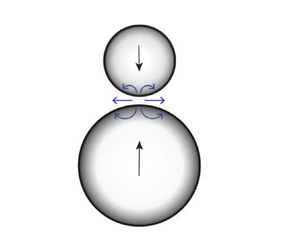Article contents
Near-contact approach of two permeable spheres
Published online by Cambridge University Press: 19 August 2021
Abstract

An analysis is presented for the axisymmetric lubrication resistance between permeable spherical particles. Darcy's law is used to describe the flow in the permeable medium and a slip boundary condition is applied at the interface. The pressure in the near-contact region is governed by a non-local integral equation. The asymptotic limit  $K=k/a^{2} \ll 1$ is considered, where
$K=k/a^{2} \ll 1$ is considered, where  $k$ is the arithmetic mean permeability, and
$k$ is the arithmetic mean permeability, and  $a^{-1}=a^{-1}_{1}+a^{-1}_{2}$ is the reduced radius, and
$a^{-1}=a^{-1}_{1}+a^{-1}_{2}$ is the reduced radius, and  $a_1$ and
$a_1$ and  $a_2$ are the particle radii. The formulation allows for particles with distinct particle radii, permeabilities and slip coefficients, including permeable and impermeable particles and spherical drops. Non-zero particle permeability qualitatively affects the axisymmetric near-contact motion, removing the classical lubrication singularity for impermeable particles, resulting in finite contact times under the action of a constant force. The lubrication resistance becomes independent of gap and attains a maximum value at contact
$a_2$ are the particle radii. The formulation allows for particles with distinct particle radii, permeabilities and slip coefficients, including permeable and impermeable particles and spherical drops. Non-zero particle permeability qualitatively affects the axisymmetric near-contact motion, removing the classical lubrication singularity for impermeable particles, resulting in finite contact times under the action of a constant force. The lubrication resistance becomes independent of gap and attains a maximum value at contact  $F=6{\rm \pi} \mu a W K^{-2/5}\tilde {f}_c$, where
$F=6{\rm \pi} \mu a W K^{-2/5}\tilde {f}_c$, where  $\mu$ is the fluid viscosity,
$\mu$ is the fluid viscosity,  $W$ is the relative velocity and
$W$ is the relative velocity and  $\tilde {f}_c$ depends on slip coefficients and weakly on permeabilities; for two permeable particles with no-slip boundary conditions,
$\tilde {f}_c$ depends on slip coefficients and weakly on permeabilities; for two permeable particles with no-slip boundary conditions,  $\tilde {f}_c=0.7507$; for a permeable particle in near contact with a spherical drop,
$\tilde {f}_c=0.7507$; for a permeable particle in near contact with a spherical drop,  $\tilde {f}_c$ is reduced by a factor of
$\tilde {f}_c$ is reduced by a factor of  $2^{-6/5}$.
$2^{-6/5}$.
- Type
- JFM Papers
- Information
- Copyright
- © The Author(s), 2021. Published by Cambridge University Press
References
REFERENCES
- 7
- Cited by



